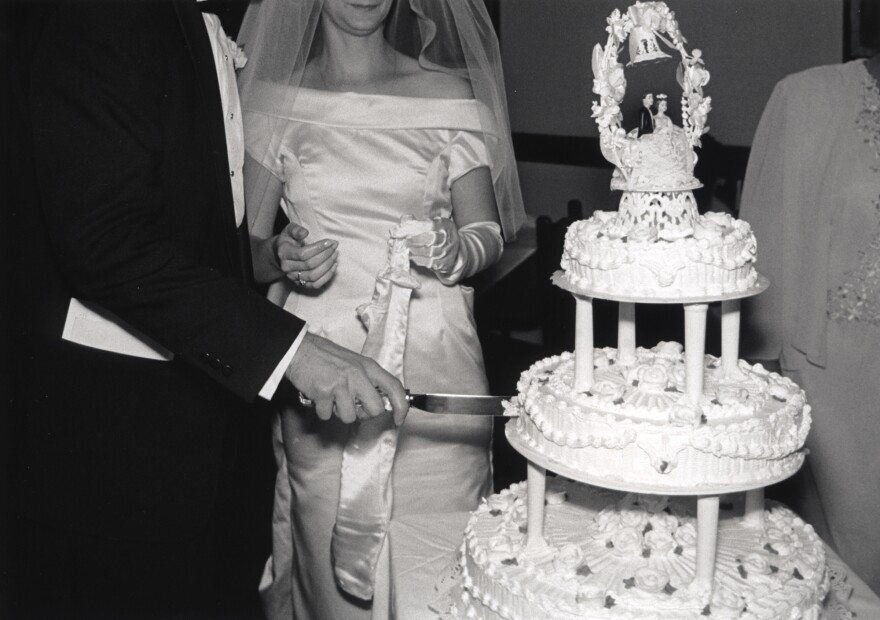On June 2, 1886, 28 fashionable guests gathered solemnly in the Blue Room of the White House in anticipation of a rare matrimonial event.
President Grover Cleveland, a notorious bachelor at 49, was to wed 21-year-old Frances Folsom after a yearlong clandestine engagement. Wedding invitations had been sent only five days before.
Never before — or since — had a sitting president taken his vows in the White House. But while many facets of Cleveland's executive affair resembled 21st-century wedding revelry, the Blue Room ceremony would seem strange in some ways to a modern wedding guest.
The newlyweds did not kiss to seal their vows; the stoic president detested such a public display of affection. And the cake was far from a white-frosted, tiered confection.
The Clevelands celebrated with a 25-pound nut-laden fruitcake, which was common for wedding cakes until almost the 20th century, says Claire Stewart, author of As Long as We Both Shall Eat: A History of Wedding Food and Feasts.
As Stewart, a former executive chef and culinary management professor, explains in her new book, "the white layered confection known today is a fairly modern invention." But the rituals of the cake, including joint cutting and sharing, are centuries old.
Stewart believes that studying the feasts and fancies of weddings past offers so much more than historical detail. It provides insight into our own lives — why we celebrate as we do today.
For example, the symbolism behind cake traditions likely encompasses a complex mix of purity, fertility and superstition.
"Ancient Roman wedding ceremonies were finalized by breaking a cake of wheat or barley (mustaceum) over the bride's head as a symbol of good fortune," Carol Wilson writes in the food studies journal Gastronomica.
It's likely this particular ritual was also a very public display signaling the groom's new possession of his bride's virginity. Modern wedding cakes, with their snowy white and flowery exteriors, can be seen as an extension of this same concept.
But the modern wedding cake's rise to "visual cornerstone and iconic marriage symbol" is just one aspect of the feast of wedding history that Stewart's book serves up.
As privileged guests raised a glass to the newlywed President and Mrs. Cleveland, they were likely unaware they were partaking in a toasting practice dating back as far as the sixth century. Stewart writes that the tradition of the champagne wedding toast "stems from a time when unions between warring factions could serve to forge peace."
A celebratory sip from a communal cup by the father of the bride at a reception once signified to all in attendance that the provided wine was safe to consume. And clinking glasses together might be part of a long-held superstition that the sound scared away the devil. Even the term "toast" likely stems from "a time when spirits were often rancid, and a piece of spiced bread was put into the cup to improve the flavor," Stewart writes.
Wedding trends — as well as standards of etiquette — have historically trickled down from the upper echelons, Stewart explains, "with the lower classes eager to replicate the restrained behavior of their so-called betters."
In the Renaissance era, for example, "peasants or the lower classes had very raucous wedding affairs, with lots of drinking and games. It was considered a giant party where everyone and anyone was invited." These boisterous parties were also meant to prove that a bride's family could afford to throw an extravagant celebration.
But, according to Stewart, "the wealthy elite didn't have to work to project wealth," so their wedding celebrations were much more subdued. Soon, upwardly mobile members of the middle class took notice of how the wealthy elite incorporated specific guest lists and careful itineraries into their wedding festivities. By the 1800s, the more "staid wedding repast" became the idealized wedding for everyone.
During the Victorian age, when restraint and propriety were paramount virtues, the focus of the wedding celebration suddenly shifted away from the food and onto the decorations.
"Victorians tended to see all indulgence as filthy. The consumption of food in general seemed to them a rather animalistic endeavor — one they wanted to distance themselves from as much as possible," Stewart says. It was impolite to even comment on the wedding food at all.
Blame this for the intense importance that some modern couples put on centerpieces and wedding favors.

An edition of the The Dodge City (Kan.) Times, dated June 10, 1886, reveals that guests at Cleveland's wedding were sent home with "satin boxes containing dainty pieces of the bridal cake, each one bearing the hand-painted monogram "C.--F." While presumably most revelers ate their gifts shortly after the wedding, at least a couple of pieces have been preserved for posterity.
The Grover Cleveland Birthplace museum in Caldwell, N.J., houses a 130-year-old slice in its collection — albeit with one bite missing. As the story goes, a visiting Cub Scout was dared to take a tiny nibble in the 1950s.
After more than 60 years in a decaying cardboard box, the cake couldn't have tasted very good.
Then again, it is fruitcake: black, cement-like and heavy - so perhaps it was simply impossible to tell.
Nicole Jankowski is a freelance food, history and culture writer based in Detroit. You can find her on Facebook here.
Copyright 2021 NPR. To see more, visit https://www.npr.org. 9(MDA5NTM4MTIyMDE0MTg3NDc2MTVlZjdmNQ001))



